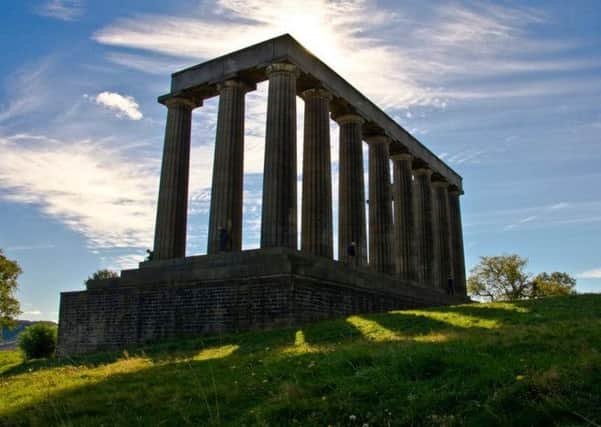Lost Edinburgh: Edinburgh’s Disgrace


Having existed in a barely half-finished state since the 1820s, it is known to locals as ‘Edinburgh’s Disgrace’.
• Visit Lost Edinburgh on their Facebook page, and follow them on Twitter @lostedinburgh
Advertisement
Hide AdTo commemorate the Scottish soldiers and sailors who lost their lives fighting in the Napoleonic Wars (1803-1815), it was decided that a national monument be erected in the capital. After careful consideration, the summit of Calton Hill was favoured over the Mound as the monument’s location in 1822. The immense 6-ton foundation stone was laid later that year by George IV.
Parthenon of Athens
The plans by celebrated architect William Playfair, to accurately emulate the appearance of the Parthenon on the Athenian Acropolis, (in keeping with Edinburgh’s coveted moniker as ‘Athens of the north’), were extraordinarily ambitious. The building was to have the external quality of the Parthenon, but inside it would operate as a church with catacombs planned underneath.
Prominent figures including Sir Walter Scott, Lord Elgin and Lord Cockburn helped to promote the project and were instrumental in the search for subscribers to raise the vast sum of £42,000 required to complete the work.
Lack of funds
Incredibly, with only one third of the total funds collected, it was decided that work would begin on the structure in 1826. Installing each of the monument’s twelve colossal Doric columns presented a huge challenge. Each section required the brute force of 12 horses and 70 men to haul the blocks of stone from out of Craigleith Quarry and up to the summit of Calton Hill more than 3 miles away. The monument provided work for more than 300 men at its peak. However, by 1829, with the west section of the monument beginning to take shape, it was announced that the funds had dried up. With just the base and twelve columns complete, the project was abandoned.
Reasons for failure
The early enthusiasm to construct a national memorial in the years immediately after the Napoleonic Wars had quickly waned over the decade. Edinburgh in the 1820s was a city of rapid change as the town continued to sprawl outwards. The National Monument was just one of several large-scale civic construction projects going on at the time. Subscribers were simply stretched to the limit and the elaborate Parthenon replica’s huge cost (estimated by some to be as high as £70,000) simply put a lot of potential benefactors off.
Completion attempts & Nashville Parthenon
Despite several attempts to revive building work on the National Monument it remains very much unfinished. As such, the monument is rarely referred to by its official name and is widely known as ‘Edinburgh’s Disgrace’. At one stage, Glasgow council even offered to complete the monument – as long its coat of arms could be visible. Edinburgh declined, hence one of its other names: ‘the pride and the poverty’.
Advertisement
Hide AdIn 1897, the city of Nashville showed Edinburgh how it’s done when a magnificent full-scale replica of the Parthenon was undertaken and completed to celebrate the 100th anniversary of the state of Tennessee.
To this day Edinburgh’s stab at the Parthenon stands in a lesser state than even its crumbling Ancient Greek predecessor. Barely a stone has stirred for well over 180 years – not that anyone appears to be particularly fussed, least of all the city’s tourists who enjoy scaling it throughout the year.
• Visit Lost Edinburgh on their Facebook page, and follow them on Twitter @lostedinburgh